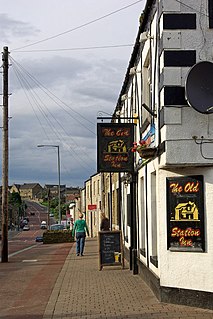
Bishop Auckland railway station serves the town of Bishop Auckland in County Durham, England. The station is the western terminus of the Tees Valley Line 12 miles (19 km) north of Darlington.

Barras railway station was situated on the South Durham & Lancashire Union Railway between Barnard Castle and Kirkby Stephen East.

The Durham to Bishop Auckland Line was a railway line originally built by the North Eastern Railway (NER) to provide rail transport access to coal mines in West County Durham. It closed under the Beeching Axe to passenger traffic in May 1964, and freight in 1968. Today it forms the major part of the 9 miles (14 km) Brandon to Bishop Auckland rail trail.
Penshaw railway station served the village of Penshaw, Tyne and Wear, England from 1840 to 1964 on the Leamside line.
Hepscott railway station served the village of Hepscott, Northumberland, England, from 1858 to 1964 on the Blyth and Tyne Railway.
Shotley Bridge railway station served the village of Shotley Bridge, County Durham, England from 1867 to 1953 on the Derwent Valley Railway.
Leamside railway station served the villages of Leamside and West Rainton, in County Durham, England from 1844 to 1953 on the Leamside line.
Washington railway station served the town of Washington, Tyne and Wear, England from 1835 to 1963, initially on the Stanhope & Tyne Railway and later the Leamside line.
Fencehouses railway station served the village of Fencehouses, Tyne and Wear, England from 1841 to 1964 on the Leamside line.
Sherburn Colliery railway station served the village of Sherburn, County Durham, England from 1844 to 1959 on the Leamside line.
Knitsley railway station served the hamlet of Knitsley, County Durham, England from 1862 to 1939 on the Lanchester Valley Railway.

Brancepeth railway station served the village of Brancepeth, County Durham, North East England from 1857 to 1964 on the Durham to Bishop Auckland Line.
Willington railway station served the town of Willington, County Durham, North East England from 1857 to 1964 on the Durham to Bishop Auckland Line.

Durham (Gilesgate) railway station served the Gilesgate area of Durham City in County Durham, North East England from 1844 to 1857 as the terminus of the Newcastle & Darlington Junction Railway Durham Branch passenger service. Its life as a passenger station was short and it was quickly converted to goods station, a role which it played for more than a century.

Eastgate railway station, also known as Eastgate-in-Weardale, served the village of Eastgate in County Durham, North East England from 1895 to 1953 as a stop on the Wear Valley Line.

Ilderton railway station served the village of Ilderton, Northumberland, England from 1887 to 1953 on the Cornhill Branch.

Brandon Colliery railway station served the village of Brandon, County Durham, England from 1861 to 1964 on the Durham to Bishop Auckland Line.
Leadgate railway station served the village of Leadgate, County Durham, England, from 1896 to 1964 on the Stanhope and Tyne Railway.

Tow Law railway station served the town of Tow Law, County Durham, England, from 1847 to 1965 on the Stanhope and Tyne Railway.

Ryhope was one of was one of two railway stations to have served the village of Ryhope, Tyne and Wear, North East England. For much of its existence, it was served by the Durham–Sunderland and Hartlepool–Haswell–Sunderland lines.










